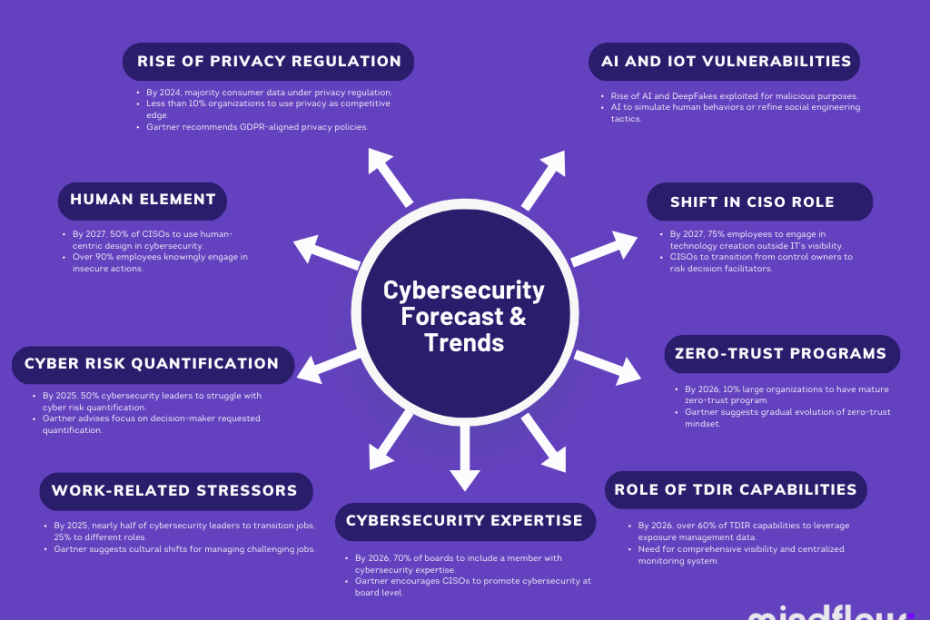In the rapidly evolving digital landscape, safeguarding against emerging cyber threats has never been more critical. As we usher in 2024, the realm of cyber security stands at a crossroads, with new challenges on the horizon.
This article aims to dissect the anticipated trends, explore potential implications, and arm you with effective strategies to fortify your digital defenses.
Current State of Cyber Security
A Brief overview of the existing cyber security landscape reveals a terrain fraught with peril. Recent years have borne witness to a surge in cyber attacks, ranging from ransomware exploits to sophisticated data breaches. To navigate the future, we must first comprehend the challenges posed by our current digital environment.
Predicted Cyber Security Trends for 2024
1. Increased Sophistication of Cyber Attacks
The battlefield of cyber warfare is evolving, with Advanced Persistent Threats (APTs) taking center stage. These stealthy and prolonged attacks pose a significant risk to organizations worldwide. Coupled with the rising trend of targeted ransomware attacks, businesses must prepare for more sophisticated assaults on their digital infrastructure.
2. Artificial Intelligence and Machine Learning in Cyber Attacks
A new frontier is emerging in cyber warfare as attackers harness Artificial Intelligence (AI) and Machine Learning (ML) to refine their strategies. The future holds AI-driven cyber attacks, necessitating the adoption of defensive AI technologies to detect and neutralize threats in real-time.
3. Internet of Things (IoT) Vulnerabilities
The proliferation of Internet of Things (IoT) devices expands the attack surface for cybercriminals. As our world becomes more interconnected, securing these devices becomes paramount. Robust security protocols and continuous monitoring are essential to mitigate vulnerabilities associated with IoT.
4. Cloud Security Concerns
The shift towards cloud adoption brings new risks. Organizations must address cloud security concerns, implementing strategies to safeguard sensitive data stored in cloud environments. Proactive measures are crucial to prevent unauthorized access and protect critical assets.
5. Supply Chain Attacks
Cybercriminals are increasingly targeting the supply chain through third-party vendors, making it vital for organizations to bolster their supply chain security. Collaboration and thorough vetting processes are imperative to ensure the integrity of the entire supply chain.
Implications and Consequences
The potential impact of these emerging threats extends beyond mere digital disruption. Organizations face financial losses, reputational damage, and operational setbacks. The consequences of falling victim to cyber threats are far-reaching, underscoring the urgency of robust cyber security measures.
Mitigation and Preparedness Strategies
To navigate the complex cyber threat landscape, organizations should adopt comprehensive strategies:
Cyber Security Awareness and Education: Elevate the knowledge and awareness of employees and users to recognize and respond to cyber threats effectively.
Implementation of Multi-Factor Authentication (MFA): Enhance authentication processes with MFA to fortify access controls and deter unauthorized entry.
Regular Software and System Updates: Prioritize timely updates to patch vulnerabilities, fortifying the overall security posture.
Incident Response Planning: Develop and regularly update incident response plans to swiftly address and mitigate cyber attacks when they occur.
Collaboration and Information Sharing in the Cyber Security Community: Foster collaboration within the cyber security community to share insights, intelligence, and best practices.
Regulatory and Compliance Landscape
As cyber threats evolve, so do regulations and compliance standards. Governments and international bodies are adapting regulations to address emerging cyber threats. Staying compliant with these standards is crucial for organizations, ensuring they meet the necessary requirements for cyber resilience.
Future Outlook
The trajectory of cyber threats beyond 2024 remains uncertain. Innovations in cyber security technologies will play a pivotal role in shaping the digital landscape. As we look towards the future, the need for continued vigilance, adaptation, and collaboration becomes increasingly apparent.
Conclusion
In the face of escalating cyber threats, individuals and organizations must prioritize cyber security. By staying informed, implementing robust strategies, and fostering collaboration, we can collectively navigate the digital perils and secure a safer digital future. The call to action is clear: fortify your defenses now to safeguard against the challenges that lie ahead.
Click here for interesting information: Belachao
